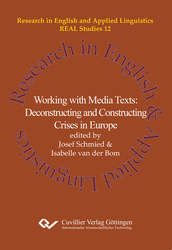| Fachbereiche | |
|---|---|
| Buchreihen (96) |
1377
|
| Nachhaltigkeit |
3
|
| Gesundheitswesen |
1
|
| Geisteswissenschaften |
2362
|
| Medienwissenschaften | 16 |
| Theologie | 57 |
| Philosophie | 102 |
| Rechtswissenschaft | 422 |
| Wirtschaftswissenschaften | 850 |
| Sozialwissenschaften | 416 |
| Sportwissenschaften | 48 |
| Psychologie | 233 |
| Pädagogik | 190 |
| Geschichtswissenschaften | 182 |
| Kunstwissenschaften | 110 |
| Kulturwissenschaften | 165 |
| Literaturwissenschaften | 116 |
| Sprachwissenschaften | 88 |
| Naturwissenschaften |
5405
|
| Ingenieurwissenschaften |
1789
|
| Allgemein |
97
|
|
Leitlinien Unfallchirurgie
5. Auflage bestellen |
|
Erweiterte Suche
Working with Media Texts (Band 12)
Deconstructing and Constructing Crises in Europe
Josef Schmied (Herausgeber)Isabelle van der Bom (Herausgeber)
Vorschau
Leseprobe, PDF (830 KB)
Inhaltsverzeichnis, PDF (160 KB)
The present volume is the productive result of multilateral academic collaboration between institutions of higher education from Germany (Chemnitz), Macedonia (Ohrid, Bitola), Albania (Vlora) and Serbia (Niš). The collaboration, funded by the German Academic Exchange Service (DAAD), was set up to establish a West-East Dialogue and a better understanding and processing of the crises in Europe through the deconstruction and construction of media texts. The contributions in this volume illustrate how ‘crises’ are constructed by the media discursively, with attention paid to the linguistic elements of media texts, and in some cases accompanying images. The authors in this volume are students and established scholars that come from different but intersecting disciplines. They each focus on different ‘crises’ in different (national) media outlets, offering new perspectives on how social, political and geographical events may be shaped by the media, and how these mediatised portrayals may in turn influence public perspectives on a range of issues.
| ISBN-13 (Printausgabe) | 9783736997097 |
| ISBN-13 (E-Book) | 9783736987098 |
| Buchendformat | A5 |
| Sprache | Englisch |
| Seitenanzahl | 230 |
| Umschlagkaschierung | matt |
| Auflage | 1. |
| Buchreihe | REAL Studies / Research in English and Applied Linguistics |
| Band | 12 |
| Erscheinungsort | Göttingen |
| Erscheinungsdatum | 21.03.2018 |
| Allgemeine Einordnung | Sachbuch |
| Fachbereiche |
Sprachwissenschaften
|
| Schlagwörter | European crises, comparative linguistics, media texts, media linguistics |








